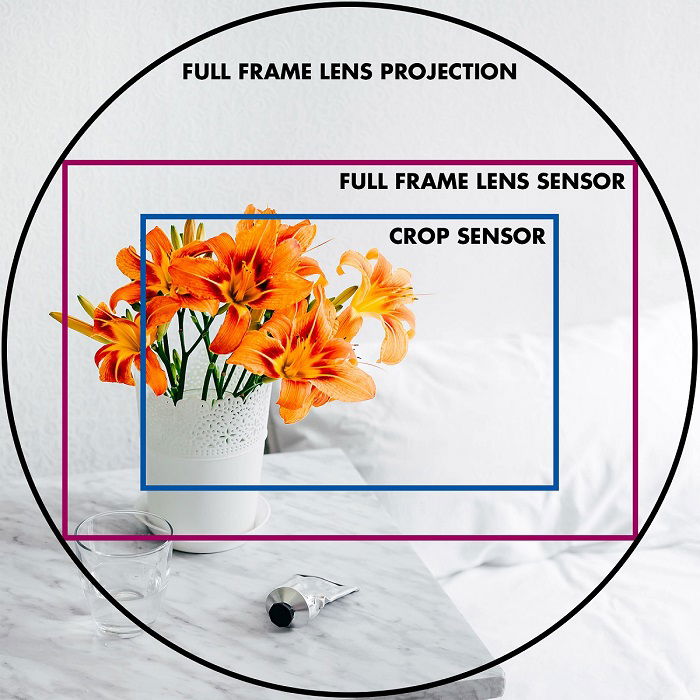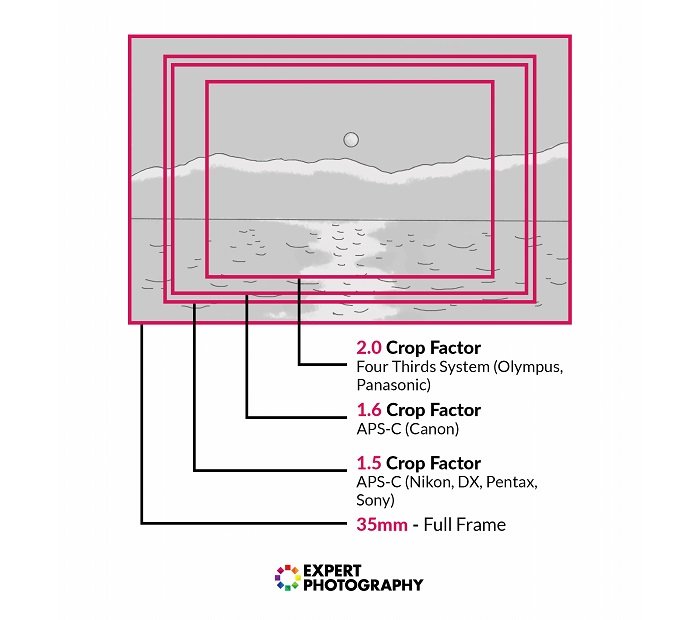What Is Equivalent Focal Length in Photography?
Equivalent focal length is something every photographer needs to know about. But while it might seem complicated at first, it’s actually quite simple once you understand the concept.
This article explains exactly what equivalent focal length is and why it’s important in photography. We look at how it relates to camera sensors, lenses, and crop factor. We’ll take it step by step, and by the end of the article, you’ll never have a problem working out your equivalent focal length.
What is Equivalent Focal Length?
The equivalent focal length is the effective focal length of a lens once the camera’s crop factor is taken into consideration.
That means a 50mm lens might not give you a 50mm field of view when attached to your camera. If your camera experiences crop factor, the equivalent focal length will be more than 50mm.
If your camera does experience crop factor, then a standard prime like a 50mm might actually have a 75mm equivalent focal length despite what the lens’s label says.
As you can see, we can’t fully understand the equivalent focal length without looking at crop factor.
What is Crop Factor?
Crop factor is where the field of view from your camera is smaller and more magnified compared to a full frame camera.
Full frame sensors are the same size as 35mm film cells from the analog photography. We call them full frame because the frame is full and not cropped.
That means full frame cameras experience no crop factor. A 50mm lens is always a 50mm lens when paired with a full frame camera.
Cameras with APS-C and Micro Four Thirds sensors experience crop factor because their sensors are smaller than full frame (35mm). They are “cropped” around the sides.
The crop factor gives you a narrower, more magnified field of view and more magnification. And the smaller the sensor, the more extreme the crop factor.
Crop Factor on APS-C Cameras
APS-C cameras are also often called “crop sensor” or “crop” cameras because they have cropped sensors. That is, the APS-C sensor is smaller than a full frame sensor.
APS-C cameras from Nikon, Sony, and Fujifilm have a crop factor of 1.5x. Canon APS-C sensors are slightly smaller, so they give you a crop factor of 1.6x.
But what does a 1.5x crop factor mean? It means the effective focal length of the lens attached is the labeled focal length x the crop factor value. The result is your equivalent focal length.
If you’re using a 50mm lens on a Nikon APS-C camera, the equation is 50 x 1.5, which equals 75. That means the equivalent focal length of this lens is 75mm.
If you’re using a 50mm lens on a Canon APS-C camera, the equation is 50 x 1.6 = 80. The equivalent focal length of the lens is 80mm.
You don’t have to worry about crop factor if you use specialist crop-sensor lenses. These are lenses made especially for APS-C cameras. If you’re using a Nikon, they are DX lenses. If you’re using a Sony camera, they are E lenses, not FE lenses.
Crop Factor on Micro Four Thirds Cameras
Micro Four Thirds (MFT) sensors are even smaller than APS-C sensors. That means the crop factor is even more pronounced.
While an APS-C sensor has a crop factor of 1.5, MFT sensors have a crop factor of 2x.
Even though the crop factor is now stronger, we can use the same equation (focal length x crop factor) to calculate the equivalent focal length of the lens.
Let’s attach a 50mm lens to a Micro Four Thirds camera. It’s 50 x 2 = 100, so the equivalent focal length is 100mm.
Calculating The Equivalent Focal Length
As we’ve seen, there’s a universal equation that allows us to calculate the equivalent focal length for any lens and camera combo. All you need to know if the lens’s focal length and the camera’s crop factor.
The equation is focal length x crop factor = equivalent focal length.
We’ve put this equation to use with 50mm lenses. That’s a good starting point, but you will need to know how to calculation the equivalent focal length with any lens and camera.
Below is a table with common focal lengths and their equivalent focal length values when crop factor is considered. This table should help you calculate equivalent focal lengths in the future.
Why is the Equivalent Focal Length Important?
As we’ve seen, even a small amount of crop factor can have a big influence on the equivalent focal length of your lens.
If you’re using a 50mm lens with a Nikon APS-C camera, the equivalent focal length is 75mm. That means the lens has changed from a standard prime to a telephoto prime. It completely chances the purpose of the lens.
If you want to shoot street photography with your 50mm but it’s giving you a 75mm field of view, you’re going to find it tricky to get the shots you want. The problem is even more pronounced if you’re using a Micro Four Thirds camera.
Similarly, if you buy a 24mm lens for your MFT camera expecting a wide angle, you’ll have an unpleasant surprise. The 2x crop factor gives you an equivalent focal length of 48mm, making it a standard-angle lens.
You might be wondering why don’t manufacturers label the lenses with the equivalent focal length rather than the full frame focal length.
While this might save some confusion for the user, the focal length is a mechanical measurement within the lens. If they were to change that, the whole system of lens measurements would collapse.
That’s why you need to be able to workout the equivalent focal length with any combination of camera and lens.
Conclusion
Every photographer needs to understand equivalent focal length to know what kind of angle of view they’ll see when the lens is paired with their camera.
Crop factor plays a big role in how a lens actually functions. It can turn a wide-angle lens into a standard-angle lens, and a standard into a telephoto. That makes a huge difference to the lens’s capabilities.
But once you know the equation, working out the equivalent focal length is easy. You’ll be able to do it with any crop-sensor camera and any lens, allowing you to shoot whatever you want whenever you want.











